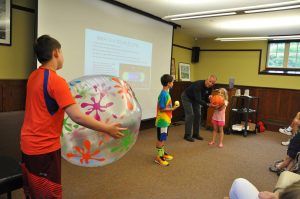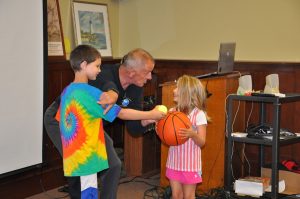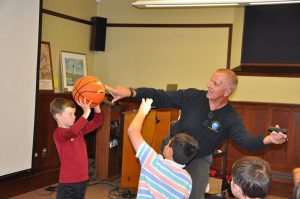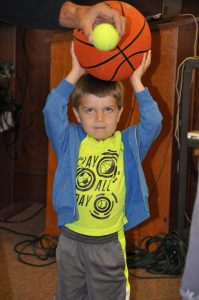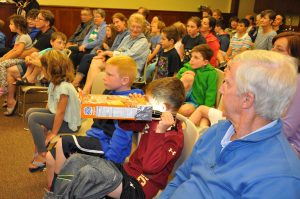Excited kids, parents and grandparents packed the downstairs room at the Mattapoisett Free Public Library to listen to Roger Menard of the Astronomical Society of Southern New England talk about the upcoming solar eclipse on August 21.
Menard, a member of the ASSNE that promotes the joy of astronomy and supports STEM education, provided a hands-on experience, demonstrating details of the eclipse phenomenon with the help of the audience. A total eclipse happens once every 18 months or so, but has not been visible in North America since 1991. In any one place on earth, a total eclipse occurs every 360-400 years.
Menard invited kids from the audience to the front of the room to demonstrate why an eclipse doesn’t happen every month that the moon travels around the earth. With a beach ball for the sun, a tennis ball as the moon and a basketball representing the earth, Menard showed that the moon does not orbit the same path every month; therefore, it is not on the same plane as the sun and does not always create an eclipse, or shadow. Also, the earth spins on its axis at approximately 23 degrees, and the moon has an elliptical orbit around the earth, creating different eclipse pathways at different times of the year.
This year, the Path of Totality or umbra, in which someone on earth will be able to see the total eclipse of the sun, is approximately 125 miles wide and runs from Lincoln City Oregon to Charleston South Carolina. Here in Massachusetts, we will see a partial eclipse, called the penumbra, in which the moon will block about 70% of the sun, and we won’t see significant darkening of the daylight.
It may be easier to look at the sun when it is partially or completely eclipsed because it is not as bright, but the light can do permanent damage to the eye’s retina. Viewers are warned to protect their eyes with eclipse viewing glasses.
Menard also demonstrated how to create a pinhole viewer using a cereal box, with which a viewer can safely watch the eclipse. During the totality phase of the eclipse, which during this event will last about two and a half minutes, it is safe to look briefly at the sun and what Menard described as its “whispy corona.”
While we know better now, there was a time when societies regarded the solar eclipse as a bad omen or a sign of the end of the world. Ancient Chinese and Indonesians, as well as the Roman and Greeks, believed that a dragon ate the sun, while in Siberia a vampire was thought to be responsible for the astronomical event and a frog was blamed in Vietnam.
Science has since shown us that what is actually occurring is what Menard described as a “fluke of orbital geometry” that happens nowhere else in the universe, in which the moon, while being 400 times smaller than the sun, is 400 times closer to the earth and therefore with the right combination of orbit trajectories can at certain times completely block out the sun from the earth. Our moon is the only moon in the universe that eclipses the sun perfectly.
The first phase of the eclipse, called First Contact, is when the moon’s shadow takes its first bite out of the sun. The Second Contact occurs minutes before totality in which distinct balls of light, called Bailey’s Beads, are visible at the edge of the sun. Totality occurs, for a maximum of seven minutes, after which Third Contact occurs where what is known as a Diamond Ring can be seen as sunlight cuts through valleys on the moon’s surface as individual bits of light. Lastly, the eclipse ends as it began with Fourth Contact looking much like First Contact in reverse.
Menard and the Mattapoisett library provided the audience with free solar eclipse viewing glasses. The glasses cut the light by a factor of 100,000 and fully protect the user’s eyes during an eclipse. Menard warns that regular sunglasses will not provide adequate protection. Glasses must be CE-approved to provide good protection. There is a free eclipse phone app that, based on your location, will auto-calculate contact times. For our area, the eclipse will occur between 2:00 – 3:00 pm on August 21. For more information, check out eclipse2017.nasa.gov.
By Sarah French Storer
